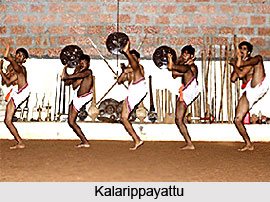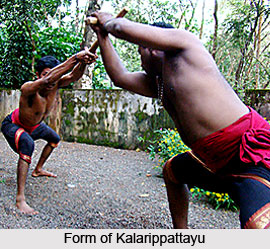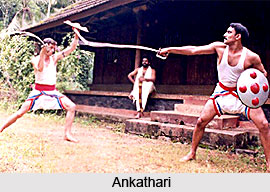 Kalarippayattu is a martial art form that originated in the state of Kerala. This ancient Dravidian art form is quite possibly one of the oldest dance forms that is in existence in India. Apart from Kerala, it is also practised in parts of Karnataka, Tamil Nadu, north-eastern Sri Lanka and the Malayali community of Malaysia. The system of Kalarippayattu consists of a system of kicks, strikes, preset forms, grappling and weaponry as well as healing methods. There are certain regional variants of the same which include the Northen, Southern and Central style. Kalarippayattu is often used in certain dance techniques by some traditional Indian dance schools as part of the exercise regimen.
Kalarippayattu is a martial art form that originated in the state of Kerala. This ancient Dravidian art form is quite possibly one of the oldest dance forms that is in existence in India. Apart from Kerala, it is also practised in parts of Karnataka, Tamil Nadu, north-eastern Sri Lanka and the Malayali community of Malaysia. The system of Kalarippayattu consists of a system of kicks, strikes, preset forms, grappling and weaponry as well as healing methods. There are certain regional variants of the same which include the Northen, Southern and Central style. Kalarippayattu is often used in certain dance techniques by some traditional Indian dance schools as part of the exercise regimen.
Origin of Kalarippattayu
The word Kalarippayattu is a combination of two words from the Malayalam language. It originates from the words `kalari` meaning meaning school and `payattu` meaning to fight or exercise. It has been estimated by noted scholars that the origin of Kalarippayattu dates back to the 12th century. Elamkulam Kunjan Pillai, a noted historian, traces the beginnings of the martial art to the period of warfare between the rulers of the Cheras and the Chola dynasty in the 11th century. Since then, it has been the right and duty of various specific subgroups of Ezhavas, Nairs as well as some Christians and Muslims to practice and exercise this art of war in the service of a ruler. In addition to this, the girls in some noble families were given this training till the onset of puberty. A few women of the noted Chekavars achieved a high degree of expertise in the same. It has been seen in the writings of early colonial historians that Kalarippayattu became widely prevalent in all of Kerala, and was practised by a majority of the population here irrespective of gender, caste and communal lines. The ancient warrior spirit was also retained throughout the centuries by the warrior chieftains of ancient Kerala known as the Mamanka Chekavar.
Forms of Kalarippattayu
Depending on the particular region of Kerala where it is most popular, Kalarippayattu can be seen existing in different art forms. Broadly speaking, these are - Northern style, Southern style and Central style.
Northern Kalarippayattu, practised in the Northern Malabar region of Kozhikode and Kannur, places more emphasis on weapons than on the use of hands in combat. The founder of this style is said to be Parashurama avatar, the sixth avatar of Lord Vishnu.
 The masters in this system are known as gurukkal or asan. The Northern style is emphasised by its meippayattu. In this system, a lot of emphasis is laid on treatment and massage, and the practices adopted are closely associated with ayurveda. The purpose of this thirumal massage is to increase the physical flexibility of the practitioner. The masseuse may use their feet and body weight to massage the person.
The masters in this system are known as gurukkal or asan. The Northern style is emphasised by its meippayattu. In this system, a lot of emphasis is laid on treatment and massage, and the practices adopted are closely associated with ayurveda. The purpose of this thirumal massage is to increase the physical flexibility of the practitioner. The masseuse may use their feet and body weight to massage the person.
Southern Kalarippayattu was practised mainly by the Nadars and Ezhavs of Kerala in the region of old Travancore, including the present Kanyakumari district of Tamil Nadu. The founder of this system is believed to be sage Agastya. Unlike the Northern style, more emphasis is laid on empty hand techniques. There are various stages of learning in the Southern system which include chuvatu (solo forms), jodi (partner training/sparring), kurunthadi (short stick), neduvadi (long stick), katthi (knife), Katara a (dagger), valum parichayum (sword and shield), chuttuval (flexible sword), double sword, kalari grappling and marma (pressure points). The masters of the Southern school are referred to as asaan. Medical treatment in the southern styles is identified with siddha, also attributed to Agastya. Closely related to the Sourthern Kalarippayattu is the silambam, the art of fighting with a stick.
Central style Kalarippayattu is mainly practised in Thrissur, Malappuram, Palakkad and certain parts of the Ernakulam district. This style is a kind of mixture, including the preliminary exercises of the North and empty handed moves of the Southern style. Along with this, techniques typical to the Central style are also practised which includes performing within the floor drawings known as kalam.
Training in Kalarippayattu
Training for the students of Kalarippayattu begins with the initiation ceremony. The students begin training at the around seven years of age with a formal initiation ritual performed by the gurukkal. On the opening day of the new session, a novice is admitted to the kalari in the presence of the gurukkal or a senior student and directed to place their right foot first across the threshold. The student shows his reverence to the gurukkal and the guruthara and offers dakshina to the guru. The guru then blesses the pupil and this entire ritual is practised everyday. The school where the martial arts are taught is the kalari, which is traditionally constructed according to the Vastu Shastra. The training area consists of a puttara (seven tiered platform) and the guardian deity who is worshipped daily before commencing practice. Kalarippayattu was developed as a kind of spiritual movement to attain moksha apart from a system of self defense. Thus Kalarippayattu aimed at serving as a vehicle to attain higher levels of spirituality and thereby attain self realisation.
Training is usually divided into four stages: Meithari, Kolthari, Ankathari and Verumkai. The first stage includes a set of exercises aimed at disciplining the body. Once the students have obtained the required level of flexibility, they are introduced to fighting with long wooden weapons in the second stage. These weapons include the staff (kettukari), cheruvadi or muchan, and the otta, a wooden stick. Once the students have become competent in handling wooden weapons, they are introduced now to metal weapons in the third stage. After having achieved a mastery over all weapons, the student is introduced to the last stage, where the art of fighting with the bare arms as a means of defence is taught. Of the various methods employed herein, marmam is the most advanced. It is the system of disabling opponents by, means of focussing on their pressure points. In order to discourage misuse of the technique, the knowledge of marmam is restricted to very few trusted students.
Techniques in Kalarippattayu
 The Atavu or techniques used in Kalarippayattu are a combination of steps (chuvatu) and stances (vadivu). Usually there are five steps and Northern styles have ten postures, the Ashta Vadivukal. Each stance has its own power combination, function and set of techniques. All the eight postures are based on animals.
The Atavu or techniques used in Kalarippayattu are a combination of steps (chuvatu) and stances (vadivu). Usually there are five steps and Northern styles have ten postures, the Ashta Vadivukal. Each stance has its own power combination, function and set of techniques. All the eight postures are based on animals.
Weapons used in Kalarippayattu
Weapons form an important part of Kalarippayattu, though they are no longer used in sparring sessions. Some of the weapons mentioned in medieval Sangam literature have fallen into disuse over time and are rarely taught in kalari payat today. Among the various weapons used im Kalarippayattu are the Kettukari (Longstaff), Kurunthadi (Stick), lathi (long stick), Urumi (flexible sword), Kuruvadi (short stick), Otta (curved stick), Gadha (mace) etc.
The art of Kalaripayattu saw a brief period of decline in the 19th century, when British colonial rule was established here. The martial art was banned altogether as it was believed as leading to rebellion and anti-colonial sentiments. The resurgence of public interest in Kalarippayattu began in the 1920s in Tellicherry as part of a wave of rediscovery of the traditional arts throughout south India and continued through the 1970s surge of general worldwide interest in martial arts. Further efforts have been made to popularise it in recent years by featuring Kalarippayattu in recent movies and popular public forums.



















